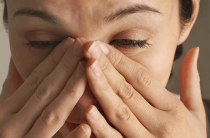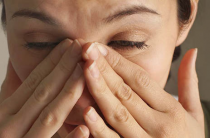Allergy combines a diverse group of diseases that occur as a result of an acute immune response to certain stimuli. Allergy symptoms break out only if the allergen has entered the body in one way or another. Although a fairly large amount of information has accumulated about allergic diseases, at the moment it is not possible to say exactly why some people become allergic and others do not.
Various substances enter our body, along with food, water, inhaled air, etc. This is an obligatory part of our life, as well as the influence of the environment in the form of a certain amount of heat, air humidity and other important characteristics. A healthy person adequately tolerates the impact of those factors that do not harm his health. In an allergic person, things are quite the opposite, the most harmless factors can be perceived by his immune system as potentially dangerous. As a result, allergy symptoms appear.
Allergy symptoms can be completely different, sometimes not at all similar to each other. Basically, with an allergic reaction, organs such as the eyes, skin, nose, and respiratory system are involved in pathological immune processes. If we are talking about the reaction of the skin to the penetration of the allergen, then it is expressed by various kinds of rashes, swelling, itching and irritation. The respiratory system reacts to the penetration of the allergen with a cough, runny nose, sometimes symptoms of bronchial asthma may develop.
As soon as you encounter manifestations of an allergy, you need to immediately visit a doctor. Even if the allergy is in a relatively mild form and does not cause significant concern, it is necessary to take urgent measures for diagnosis and treatment. Indeed, in the future, it is possible to increase the severity of the symptoms of the disease if special measures are not applied for a long time.
Skin signs of allergy
The largest organ of the human body, both in terms of mass and volume, is the skin. They have developed immunity, which is necessary for protection against harmful substances and their excretion. The same circumstance makes our skin extremely vulnerable to the effects of immune reactions. Most often, skin signs of allergy can be found in the framework of food allergies, sensitivity to the components of hygiene and cosmetics, drugs, insect bites.
Dermatitis
Dermatitis is a skin disease caused by immune processes of allergic-inflammatory origin. Its symptoms can occur if the allergen substance has a direct effect on the skin, or after it has entered the body.
Signs of dermatitis are quite characteristic, making it possible to distinguish it from other skin diseases, including those of an allergic nature. Dermatitis has a consistent development: first, there is an expansion of local blood vessels, in the focus of inflammation, which is accompanied by their swelling and redness; then peculiar formations are formed in the form of frequent small dots filled with liquid. At the final stage, a dry crust is formed from this liquid; instead, there may also be erosive areas formed by a violation of the integrity of the nodular rash. Dermatitis is accompanied by extremely intense itching, and in the case of extensive manifestations, it can also cause pain. This is especially true in cases where it is located on the elbows, knees, fingers or neck. If dermatitis is acute, then scars may remain in the places of its localization, after elimination.
Hives
Another symptom of an allergy is hives. This type of skin-allergic reaction is characterized by rashes, which are represented by blisters of red or pink color. Unlike burns and other blisters, with urticaria, they only slightly, and sometimes barely noticeably, rise above the surface of the skin. In places where the rash appears, an increase in temperature is formed, which, if it is extensive, can lead to a deterioration in general well-being. In most cases, patients with urticaria are prone to acute attacks of pruritus.
The diameter of the blisters with urticaria is different. It can be both large formations and frequent, small rashes. The symptoms of this sign of a skin-allergic reaction are due to a decrease in the vascular resistance of the external capillaries, as a result of which they expand, filling the areas of the inflammatory reaction with blood, and also contribute to the penetration of fluid. For this reason, urticaria is a complex edematous-inflammatory process that requires a diverse approach to therapeutic action.
Neurodermatitis
If dermatitis is a disease of purely allergic origin, then neurodermatitis is a neuro-immune disorder. Firstly, this is due to the fact that nervous tensions (stress, emotional shock, mental breakdowns) have an intense influence on its symptoms; and secondly, the direct role of nervous factors as an impetus for the development of this disease.
And so, if nervous factors aggravate the skin symptoms, can the skin symptoms aggravate the nervous breakdown? The answer is unequivocal - yes. And this is of great difficulty for the patient, because in this way the nervous breakdown resulting from skin irritations also strengthens them.
Neurodermatitis, as a symptom of allergy, is a skin-inflammatory process that occurs along with the expansion of local capillaries, which contributes to redness and swelling. In general, these processes, although they are the main signs of neurodermatitis, are not as pronounced as in some other skin-allergic reactions. Symptoms of neurodermatitis most often affect the skin of the face, elbows and knees, genitals and thighs. Although, with further development, it can form on the chest, back, abdomen and legs.
The rash is most often represented by the formation of blisters with a large amount of internal fluid, which over time can form yellowish indurations. Itching with neurodermatitis has an extremely strong form. A hot shower, in this case, can provide relief, but only temporary.
Allergy symptoms and the respiratory system
The respiratory organs (nose, larynx, lungs, bronchi) are highly sensitive to allergens. This is due to the fact that in addition to the respiratory function, they also actively remove harmful substances to the outside, with the help of sneezing, coughing, and sputum production. With allergies, the body perceives harmless substances as a potential source of threat, therefore, it reacts to them in the same way as to the penetration of microbes or parasites.
Most often, allergy sufferers are faced with inflammatory processes in the nasal sinuses. These phenomena occur in response to the ingress of allergens along with the inhaled air. These signs of an allergic reaction are experienced by patients with allergies to plant pollen, animal dander and other components that are present in the air. The common name for these processes is allergic rhinitis. It should not be confused with common rhinitis, which is viral or bacterial in nature.
Allergic rhinitis can be recognized by the following signs:
- frequent sneezing, which occurs almost instantly, after interaction with allergens;
- nasal congestion, redness and irritation of the nasal passages;
- sore throat, reminiscent of colds;
- swelling that also develops around the sinuses;
- allergic cough.
The appearance of allergic rhinitis, after contact with the allergen, interferes with normal breathing processes, because its most natural form is the inhalation of air through the nose. As a result, the patient breathes heavily through the mouth. Disturbed oxygen supply provokes headaches, increased fatigue and insomnia.
Allergy symptoms and organs of vision
The eyes are another sensitive one that reacts sharply to allergens. If the provocative substance enters the mucous membrane of the organs of vision, then, subject to the appropriate sensitivity of the immune system, the patient begins to experience signs of an allergic reaction. A group of allergy symptoms affecting the eyes and surrounding areas is called allergic conjunctivitis.
Signs of allergic conjunctivitis:
- intense lacrimation;
- vasodilatation of the eyes;
- eye redness;
- swelling of the eyelids;
- itching in the eyes;
- burning and discomfort;
- fear of bright lights.
Often, the symptoms of allergic conjunctivitis and rhinitis intersect as part of an allergy to plant pollen, cosmetics and perfumes, animal dander, and house dust.
Bronchial asthma as a sign of allergy
Another common symptom of allergen penetration through the respiratory system is bronchial asthma. Certain allergens can have an extremely high prevalence in the air, so it is necessary to find out the cause of asthmatic attacks and do everything necessary to minimize its pathogens in the surrounding air.
Allergic bronchial asthma develops as a result of the combined sensitivity of the bronchial tree and the patient's immune system. The immune system starts a chain of reactions immediately after the antibodies signal the invading allergen. As a result, special substances are released that provoke hypertonicity of the muscles surrounding the bronchi and contribute to inflammatory reactions inside the lungs. This leads to the fact that the muscles around the bronchi begin to contract, contributing to a strong narrowing of the respiratory gap, and the lungs begin to produce a large amount of sputum.
Acute signs of allergy
Acute signs of allergy are body conditions that occur under the influence of allergens and pose a direct threat to the life of the patient. These conditions include anaphylactic shock and angioedema.
Anaphylactic shock
Anaphylactic shock is an extremely high degree of danger to the patient. It is a group of dangerous symptoms that occur in response to the penetration of an allergen into the body. Symptoms of anaphylactic shock occur when the allergen enters the body a second time. At the first contact, no reaction occurs; during it, the immune system only recognizes and remembers the substance as a harmful agent.
Often, the patient experiences signs of anaphylaxis in the first minutes after the provoking substance has entered the body. As a result of anaphylactic shock, the respiratory tract is damaged, which causes suffocation, extensive swelling of the skin, mucous membranes and soft tissues, as well as a critical decrease in blood pressure.
Signs of anaphylactic shock:
- Extensive manifestations of urticaria. The patient notes a sharp spread of a red rash throughout the body. These transformations occur literally before our eyes, as a result of which the patient becomes covered with hives within a few tens of seconds. Often, this is the first sign indicating that the patient is susceptible to anaphylaxis;
- The heartbeat slows down, as a result of a lack of oxygen supply, the patient develops blue extremities and face;
- Extensive itching spreads throughout the body, which is a sign of an extremely acute allergic reaction;
- Spasm of the muscles surrounding the bronchi and larynx, which can cause death by suffocation.
Anaphylactic shock is a potentially dangerous condition for the body that requires emergency treatment measures.
Quincke's edema
Quincke's edema is an acute manifestation of swelling of the skin, mucous membranes and tissues with a large amount of fatty tissue. Quincke's edema most often affects the neck, face, eyelids, fingers, tongue and larynx. Swelling of the tongue and larynx is potentially dangerous, because in this case, breathing is disturbed. It can be either an independent sign of an acute allergic reaction, or it can be accompanied by extensive urticaria or develop as an integral part of anaphylactic shock.










